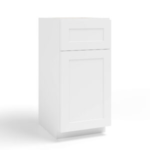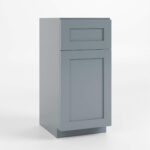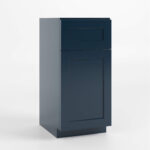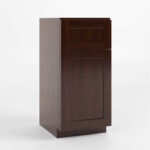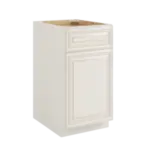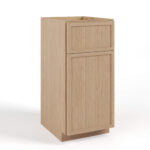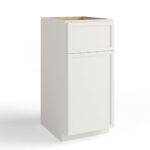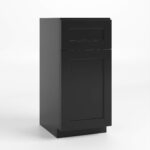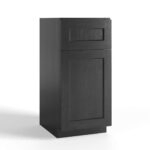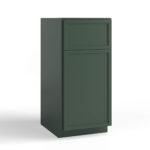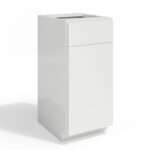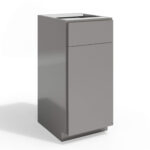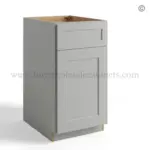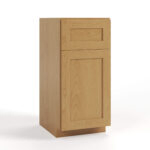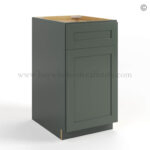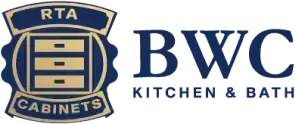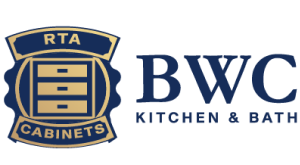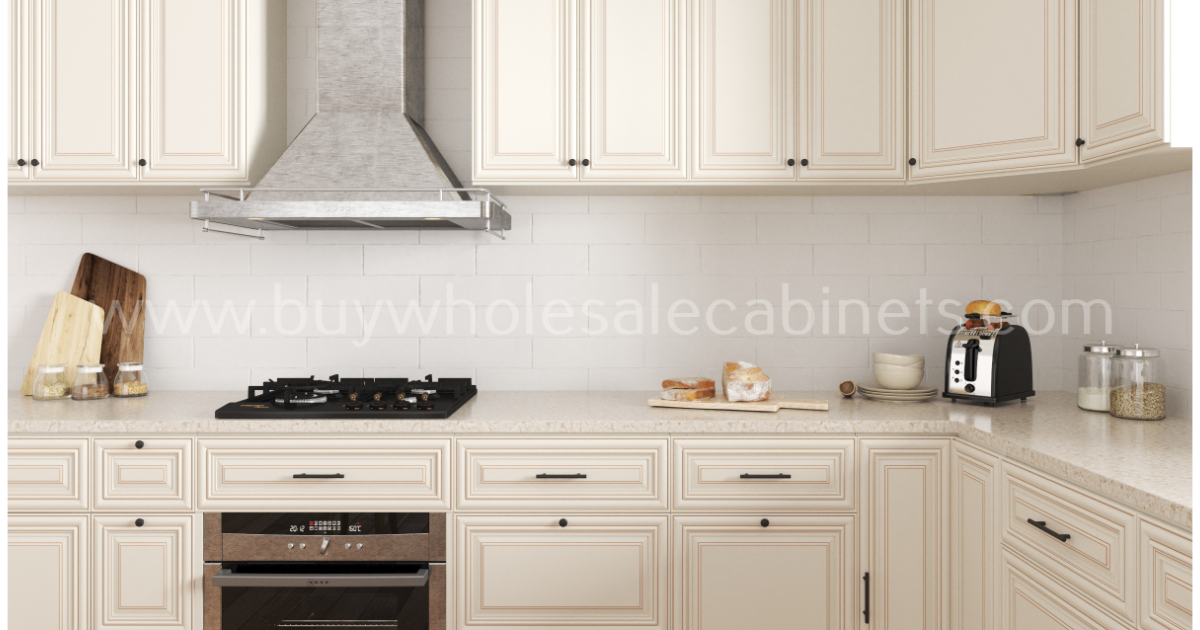Table of Contents
Cabinet doors are one of the most important features that shape the style of your kitchen. When it comes time to update your kitchen, understanding the types of cabinet doors and the elements of the materials can give you a better idea of your design preferences, whether you’re updating a few elements or completely remodeling. Whether your taste is more for raised panels or trendy, minimalist slabs, you can find cabinet door styles that suit any aesthetic and budget.
This article explores the various types of kitchen cabinet doors and materials available, along with guidance on selecting one that perfectly suits your home.
What Are the Different Types of Kitchen Cabinet Doors?
There are many styles of kitchen cabinet doors, each with a distinct appearance and vibe. Others are suitable for contemporary designs, and some are ideal for classic kitchens.
Shaker Doors
Shaker cabinet doors are among the most popular for good reason. Providing a straightforward style that complements almost any kitchen, their simplicity and clean lines offer a classic look. The standard Shaker door has a flat center panel framed by a square frame, with no embellishments or elaborate details.
The true beauty of Shaker cabinet doors lies in their versatility. With just a subtle finish or hardware change, they can seamlessly blend into farmhouse, coastal, transitional, and even modern kitchens. Shaker doors are simplistic yet classy, and you can make them from painted, stained, or natural wood.
Raised Panel Doors
The raised panel cabinet door features an inset, outgoing panel that sits atop the frame. That style offers a more traditional, detailed appearance, often characteristic of conventional or formal kitchen designs.
The design at the center can be round or square, based on your preference, and often includes decorative molding or a routed, beveled edge. Due to their solid nature, raised panel cabinet doors typically feature heavy wood, which allows for deep finishes and visible grain patterning.
Although they can add a higher level of sophistication and richness to a kitchen, raised panel doors can be more costly and more challenging to keep clean than flat panel doors due to the detailed work involved. Yet if you are after that classic, ageless aesthetic, it’s hard to beat.
Slab (or Flat) Doors
Slab doors (also known as Flat-panel doors) provide the simplest look of all cabinet door styles. Such doors are without inlay, a frame, or ornamentation, only a solid panel.
Widely used in modern and contemporary kitchens, the slab door features a flush, clean appearance that highlights its clean lines and simplicity. Depending on the desired look, you can commonly find a high-gloss lacquer, laminate, wood veneer, or even acrylic surface board.
Recessed Panel Doors
Recessed panel doors are reminiscent of Shaker style, but not identical to it. These types of doors have an inset center panel, below the face of the frame surface. Shaker doors have a clean line and a boxy frame, while recessed panel styles can feature added bevels or contours that are slightly more intricate.
This style is a perfect blend of old and new, as transitional kitchens so often are. It also provides some additional latitude for trim or finish choices, as it leaves room for personalization in the overall appearance.
Glass Doors
The glass cabinet doors add a lighter and airier touch to a kitchen by providing a space to showcase dinnerware, glassware, or decorative items. Frame them in wood, metal, or aluminum, with glass often featured on upper cabinets to provide contrast and reduce bulk.
You can select from clear glass, frosted glass, seeded glass, or textured glass, depending on how much you want people to be able to see through your shower door, as well as to express your personal taste. If you have a long run of cabinets or want an open appearance in a smaller kitchen, glass-front doors are perfect for breaking up the space.
Framed vs. Frameless
Not a style per se, but knowing the distinction between framed cabinets and frameless cabinets is essential. Framed cabinets feature a face frame that encircles the front edge of the cabinet, providing additional structure and support. Doors can mount flush to the framework and can be either inset, partial overlay, or full overlay.
Unlike framed cabinets, frameless cabinets have no front frame. The door attaches directly to the cabinet box for full access and a European-style appearance. Slab or flat-panel doors also mesh nicely with frameless cabinets that occupy 5 percent less space, yielding a little more usable space inside.
Common Materials Used for Kitchen Cabinet Doors
The materials used in the construction of your cabinet doors often determine their durability, affordability, and attractiveness. There are pros and cons to each one, depending on your design goals and budget.
Solid Wood
Solid wood is a popular choice because it is durable and beautiful naturally, and can last for a long time. Some standard wood types are Maple, Cherry, Oak, Hickory, and Walnut. Here, wood provides a warm, organic appearance with depth of grain pattern and natural variation.
Wood cabinet doors accept paint and stain, and they typically age gracefully. But in a high-humidity area, unless properly sealed, wood can warp and swell. It’s also a relatively costly material.
MDF (Medium-Density Fiberboard)
Compressed wood fibers and resin form MDF (Medium-Density Fiberboard), which results in dense, smooth panels. Since it does not have a grain that shows through the finish, and the result can be an even finish, you can use it for painted cabinet doors, as well as for Shaker and recessed panel designs.
MDF is a cheaper option than solid wood and is less prone to cracking or warping. Less moisture resistant than the recommended option, it can swell if not properly sealed or if paint chips away over time. However, it is a great budget pick for achieving a clean, professional appearance.
Plywood
Plywood, on the other hand, is a layered product consisting of thin sheets of wood veneer bonded together with adhesive. It is used frequently for cabinet boxes, but also serves as an excellent, stable, and durable material for doors.
Quality plywood is easy to withstand warping, and is lighter than solid wood. These cabinets are available with either a wood veneer or a painted finish. It is not as heavy as MDF, nor as beautiful as solid wood; yet, it still strikes a balance of solidity, durability, and affordability.
If solid cabinets are out of your budget, plywood is a nice middle ground if you still want cabinetry that will last.
Laminate
Laminate cabinet doors consist of a printed plastic film or decorative paper applied to a particle board or MDF substrate. Available in a plethora of colors, prints, and textures, including wood-look, gloss, and metallic.
Laminate is inexpensive, easy to care for, and highly resistant to stains and scratches. The finish is intrinsically susceptible to peeling or chipping the moment it is damaged, and once it does, it is difficult to restore it to its original shape.
Thermofoil
Thermofoil is a heat- and pressure-resistant vinyl coating used on MDF doors. It also mimics the appearance of painted wood, offering a smooth and easy-to-clean surface.
You can find them in several colors and designs, including Shaker and flat-panel doors. They’re affordable and long-lasting for kitchens that don’t receive heavy use, but they perform poorly in environments with excessive heat and prolonged water saturation.
Glass and Acrylic
Glass and acrylic doors introduce style and depth to your cooking space, while also helping to reflect light. Glass frames with wood or aluminum, acrylic doors are solid panels that produce a smooth, shiny surface, ideal for modern spaces.
They are both low-maintenance and work well with a minimalist aesthetic. While acrylic is scratchable, it is less fragile than glass. Glass, on the other hand, requires care, yet it exudes a timeless sophistication that is unparalleled.
Quick Comparison: Kitchen Cabinet Door Materials
| Materials | Pros | Cons | Best For |
| Solid Wood | Strong, elegant, refinishable | Costly, prone to humidity changes | Premium or traditional kitchens |
| MDF | Smooth, paintable, affordable | Swells if unsealed or chipped | Painted modern designs |
| Plywood | Durable, stable, lightweight | Slightly pricier than MDF | Daily-use kitchens |
| Laminate | Scratch- and stain-resistant, low upkeep | Chips or peels when damaged | Budget-friendly remodels |
| Thermofoil | Seamless, glossy, easy to clean | Sensitive to heat and moisture | Low-traffic kitchens |
| Glass / Acrylic | Adds light, modern appeal | Fragile, needs cleaning | Display or contemporary spaces |
Aesthetics and Finish Considerations for Kitchen Cabinet Doors
Cabinet doors offer far more than storage. They help shape the look and feel of the kitchen, given their finish, color, and texture. Even an incremental tonal or sheen shift can give your space a different feel on a day-to-day basis.
Choosing the Right Color and Finish
Color has a considerable impact on mood. Choosing light shades, such as white, blue, beige, or light grey, gives the kitchen area a look and feel of lightness and openness. Espresso, Navy, or Walnut hints at warmth and depth when toned down to a darker shade. Stains accentuate the grain of the wood and highlight the sense of variation within it, while painted doors provide a smooth, uniform appearance. Buy Wholesale Cabinets offers finishes that resist everyday wear and tear with simple maintenance, ensuring they last for years without losing their beauty.
Matching Cabinet Style to Your Kitchen Aesthetic
Every piece of cabinetry has its own unique character. Shaker doors pair well with just about any interior and complement minimalist color schemes. In more traditional spaces, raised panels lend a sense of formality. Flat doors work best with minimal hardware and modern configurations for a clean and uncomplicated vibe.
Glossy vs. Matte Finishes
Glossy finishes reflect light, giving a bright, shiny appearance. Matte finishes are more organic and have a better track record of hiding smudges. You can use both to create a lovely balance!
Wood Grain and Texture Options
Natural grain patterns create warmth and movement. Materials such as oak, maple, or hickory will exhibit more distinct grain patterns, while cherry or laminate will have less pronounced variations. The topcoat protects the surface, which allows it to remain chip-resistant and easy to clean.
How to Choose the Right Kitchen Cabinet Door for Your Kitchen
Here are some tips for choosing kitchen cabinet doors: Decide on the overall style of your kitchen, consider your household’s lifestyle, and your budget. Do you want a contemporary minimalist design, or something more classical and decorative? Are you looking for low-maintenance materials, or will you pay more for hand-crafted wood that lasts?
Also, consider the color, polish, and level of detail you want to include; some styles require more maintenance than others. If you have no idea where to start, gather some visual reference points and speak with a kitchen designer to match your goals to realistic and functional results for your space.
Conclusion
Your kitchen cabinet doors do more than serve a utilitarian function; they are what give a room its personality. From the simplicity of Shaker doors and the warmth of wood to the polished look of slab fronts, there is a style and material combination for every kitchen.
Take the time to compare door types, pieces, materials, and finishes. Consider the long game: your selection should be on-brand for what you envision your design to be, sure, but also survive daily life. Sourcing the right cabinet doors can make your kitchen both attractive and functional for decades from now, if you do a little research and planning.
FAQs
What are the most popular kitchen cabinet door styles?
Shaker doors are the most common type of cabinet door because their design will never go out of style and works in virtually any home. Flat-panel (slab) doors are second, particularly in more modern kitchens. In traditional and transitional homes, raised panel and recessed styles remain popular.
What’s the difference between Shaker and raised panel doors?
Shaker doors feature a flat panel center with a simple frame, providing a clean, minimalist look. Raised panel doors, on the other hand, feature a center panel that sits at a higher elevation than the rail and styles, giving a more complex and classic look.
Which cabinet door type is best for a modern kitchen?
Slab or flat-panel doors are ideal for modern kitchens. Characterized by smooth surfaces and minimal detailing, they complement frameless cabinets well, creating a tidy, European aesthetic.
How do I choose the right cabinet door for my kitchen remodel?
Take into consideration the style of your kitchen, your lifestyle requirements, and your budget. Select a door style that complements your space and choose materials that offer the right balance of durability, maintenance, and cost. Add hardware and finishes to complete the look.
Can I replace just the cabinet doors without replacing the whole cabinet?
Experts refer to this process as “cabinet refacing.” They replace only the doors and drawer fronts, while leaving the cabinet boxes alone. It is an economical way to breathe new life into your kitchen without undertaking a complete kitchen renovation.
What cabinet door styles are trending in 2025?
Expect to see more slab and Shaker doors in statement colors, such as navy, forest green, and matte black, in 2025. Textured timber veneer, mixed materials, and integrated handles are emerging as a trend that adds a unique touch to both modern and traditional forms.
